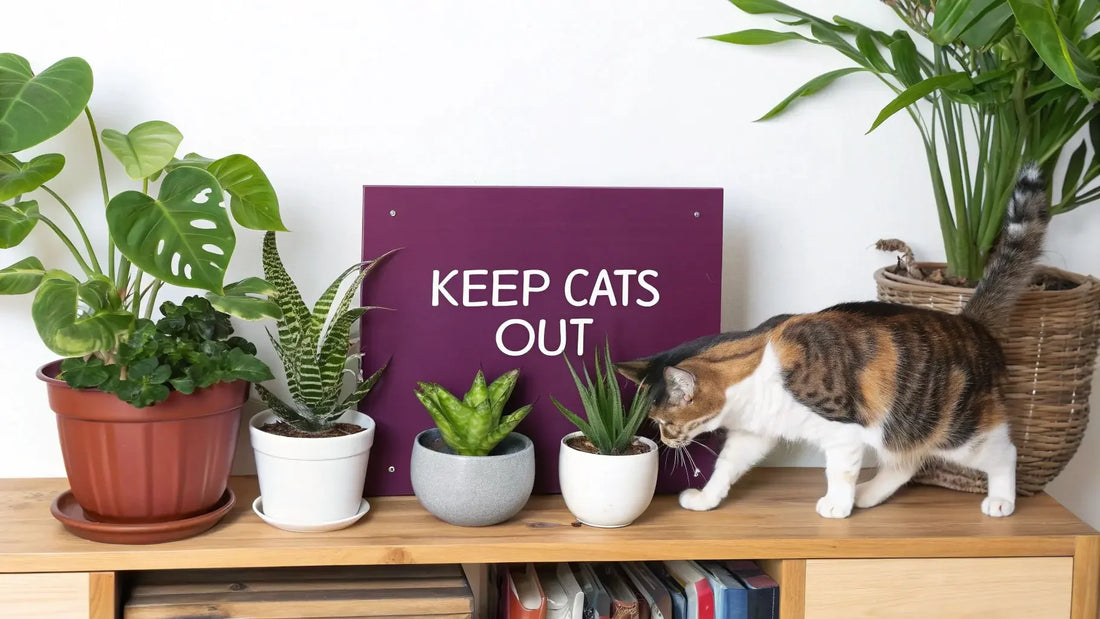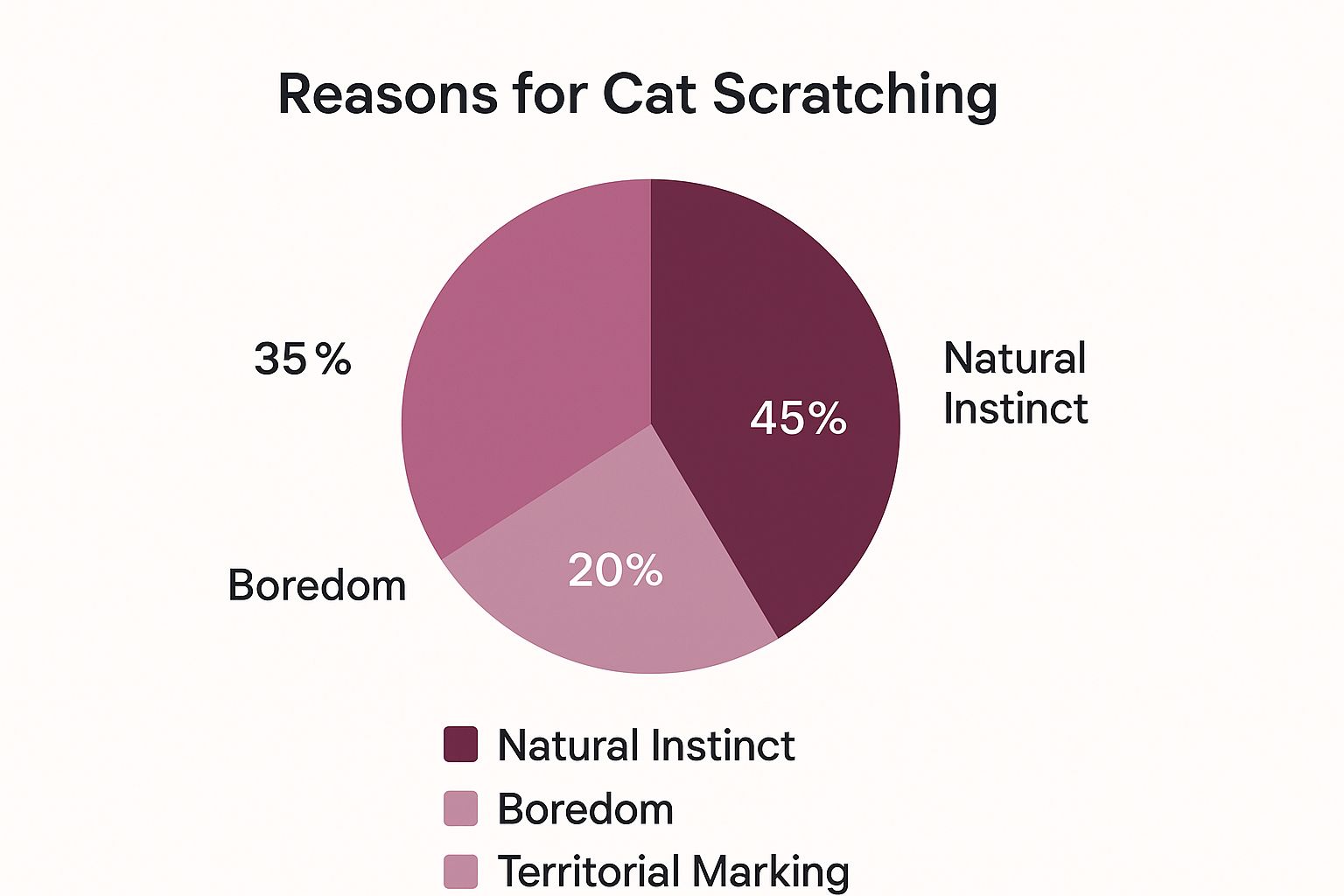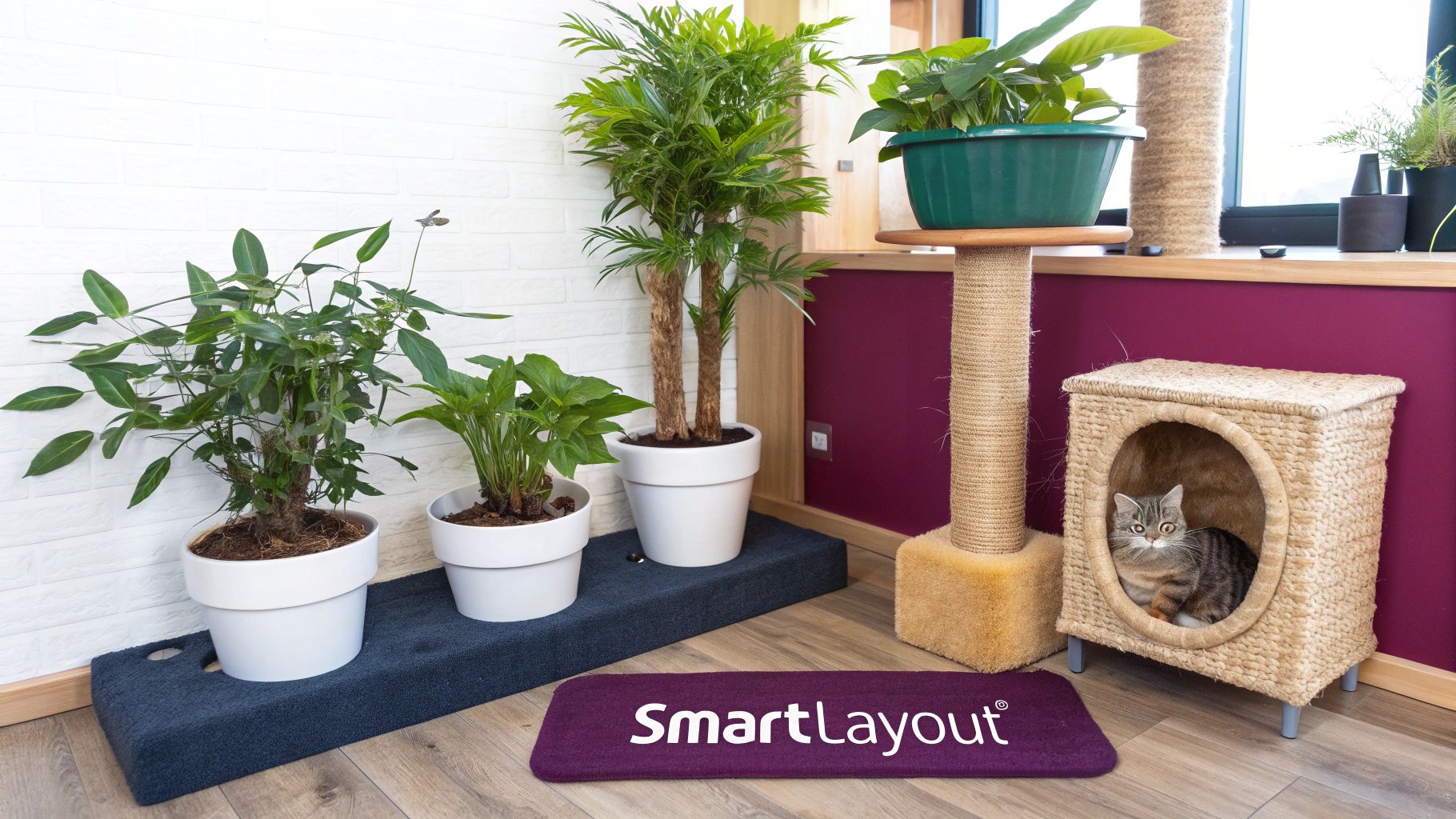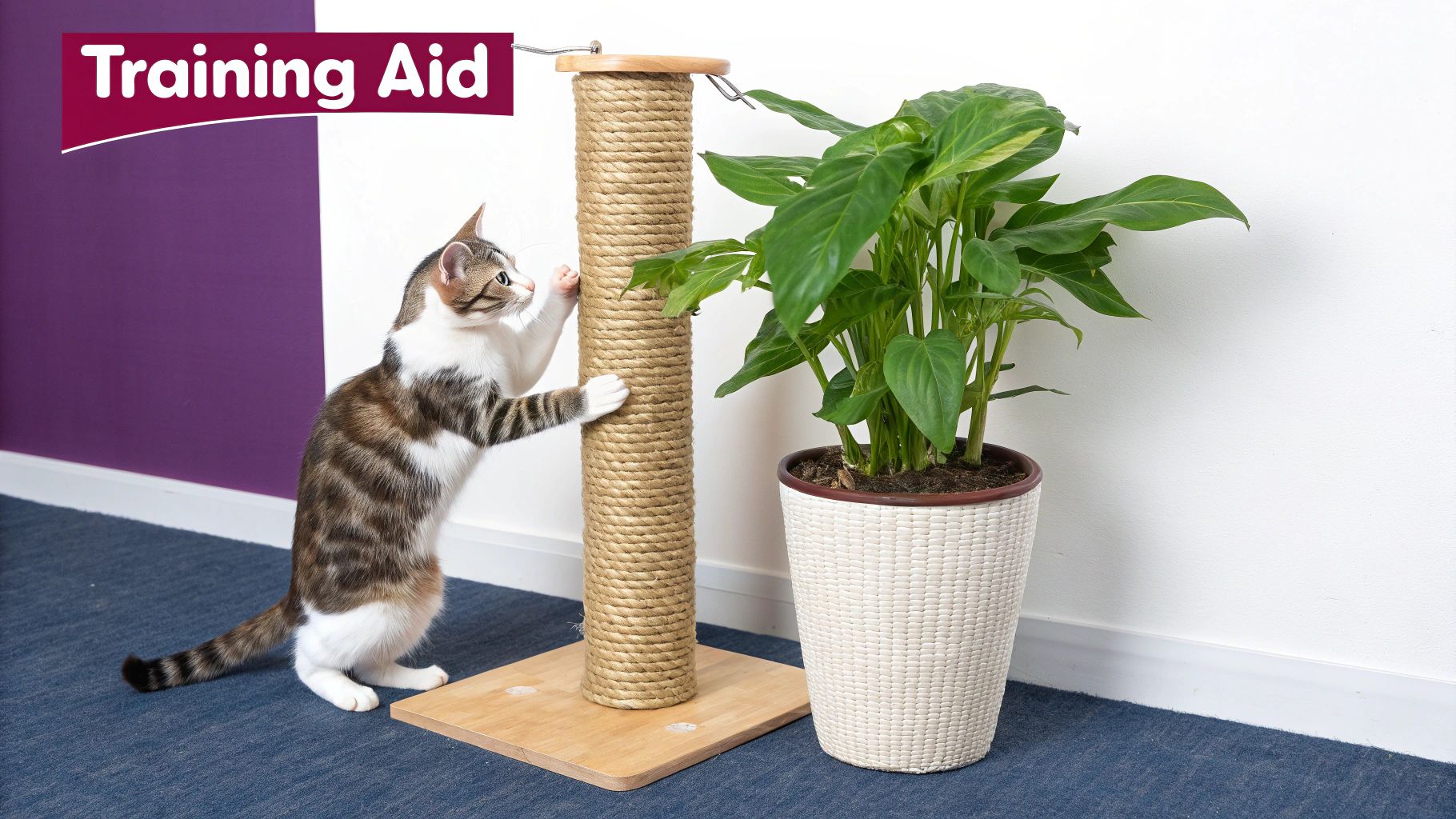How to Keep Cats Out of Potted Plants: Top Tips & Tricks

So, you're a proud parent to both a cat and a collection of beautiful houseplants? Welcome to the club! 🥳 If you’ve ever found your furry friend, much like our own mascot Floofie, treating your prized fern like a personal toilet or a chew toy, you've landed in the right spot. Let's get to the root of this mysterious behavior. 🕵️♀️🌿
Decoding Your Cat's Plant Obsession
First things first: your cat isn't staging a personal vendetta against your greenery. It’s all about instinct. Understanding what drives them is the key to creating a home where your fur babies and green babies can finally live in harmony.
That soft, perfectly damp soil in your monstera pot? To your cat, it looks like the cleanest, most luxurious litter box they've ever seen. Digging is a deeply ingrained behavior, and that freshly watered dirt is simply calling their name. Our pal Floofie can confirm!
But the obsession doesn't stop at digging. Cats are also ruled by their endless curiosity.
- The Thrill of the Chase: See those dangly leaves on your spider plant? To your cat, they're not just leaves. They're the ultimate interactive toy, perfectly mimicking the rustle and sway of prey.
- A Need to Nibble: Sometimes, a cat chews on plants just for the heck of it—out of boredom, or maybe they just like the texture. This can be a real problem, especially if the plant is toxic.
This Isn't Just About Your Ficus—It's About Your Cat's Safety
Keeping your cat away from your plants isn't just about saving your sanity (and your floors). It’s about keeping your best friend safe. A surprising number of common houseplants are actually toxic to cats, and the risk is very real. According to the ASPCA Animal Poison Control Center, plants were a factor in over 8% of all pet poisoning cases. That's a serious number.
You can learn more about how common houseplants can be a hidden danger to our feline friends at PetRadar.org.
The Big Picture: Your cat isn’t being bad—they're just being a cat. Their behavior is fueled by powerful, ancient instincts to dig, play, and explore their world with their mouths.
Once you get this, you can stop fighting a losing battle against their nature and start working with it. Instead of punishing them for doing what comes naturally, we're going to redirect that energy and make the plants way less interesting. This is the secret to finally keeping your cats out of your potted plants for good.
Using Physical Barriers to Protect Your Plants
Alright, let's get tactical. If your cat has declared your favorite monstera its personal litter box or chew toy, it's time for Operation Plant Shield. The goal here is to create simple, cat-safe obstacles that gently but firmly say, "This pot is not for you, my furry friend." It's not just about keeping cats out of plants; it's about outsmarting them with style. ✨
First up, let's make that inviting patch of soil completely unappealing. Cats have sensitive little toe beans, and we can use that to our advantage. Think about covering the exposed dirt with things they'd rather not step on.
I’ve had great success with:
- Large, smooth decorative river stones
- Chunky, slightly prickly pinecones
- A lattice of bamboo sticks or chopsticks pushed into the soil
These look surprisingly chic and make it impossible for your cat to find a comfy spot to dig or nap. Floofie gives this method two paws up for effectiveness! 🐾🐾
If you want something a bit more purpose-built, you can find plant pot guards online. These are typically plastic grids that snap together over the soil, creating a protective barrier that still allows for watering. Simple, effective, and a total no-go zone for curious paws.
Up, Up, and Away
Sometimes the best defense is a good offense—or in this case, a good ascent! If your cat can't reach the plant, they can't destroy it. It's that simple.
Hanging planters are your best friend here. A stylish macrame hanger can lift your green babies completely out of the chaos zone. High, sturdy shelves also work wonders. Just be sure to survey the area for any potential "launch pads" like nearby bookshelves, couches, or cat trees. My own little acrobat once used the back of a chair to execute a perfect leap onto a "safe" shelf. Lesson learned.
So, why are they so obsessed anyway? This gives a pretty good clue:

As you can see, a huge part of this is just cats being cats. It's often not malicious, just a mix of instinct and boredom.
Cat-Proofing Barrier Comparison
Here's a quick look at different physical barriers you can use to protect your plants, rated on effectiveness, aesthetics, and of course, Floofie's approval.
| Barrier Type | How It Works | Floofie's 'Paws-itivity' Rating ⭐⭐⭐⭐⭐ | Best For |
|---|---|---|---|
| River Stones/Pebbles | Covers soil with a lumpy, unappealing texture. | ⭐⭐⭐⭐ | Larger pots where aesthetics matter. |
| Pinecones | Prickly, uneven surface that's uncomfortable for paws. | ⭐⭐⭐⭐⭐ | Outdoor pots or a rustic indoor look. |
| Commercial Pot Grids | A plastic grid sits over the soil, blocking access. | ⭐⭐⭐⭐ | Anyone wanting a clean, uniform, and effective solution. |
| Hanging Planters | Elevates the plant completely out of reach. | ⭐⭐⭐⭐⭐ | Homes with high ceilings and a definite "no-fly zone." |
| High Shelves | Places plants on surfaces a cat can't easily jump to. | ⭐⭐⭐ | Careful placement away from "launch pads" is crucial! |
Ultimately, choosing the right barrier comes down to your cat's personality and your home's layout. A determined climber might require a hanging planter, while a casual digger might be deterred by a few simple stones.
And you're not alone in this battle! A recent survey found that a whopping 68% of cat owners successfully used physical barriers to solve their plant problems. It’s a tried-and-true method. If you're looking for more ways to blend your love for cats with your home decor, our guide on the top 10 eco-friendly cat-themed gifts has some great ideas
Engaging Their Senses with Cat-Safe Deterrents

If physical barriers aren't quite cutting it, it’s time to use your cat's most powerful feature against them: their super-powered nose! 👃 That adorable little snout is up to 40 times more sensitive than ours, which we can definitely use to our advantage. The mission is to make the plant pot smell like something your furry friend, and our mascot Floofie, would rather avoid.
The best part? Many of these scent deterrents are probably already in your kitchen. No need for harsh chemicals or complicated setups. This is all about turning "stinky" (to them, anyway) into your new secret weapon.
Floofie's Top Tip: Cats are individuals! A scent that sends one kitty running might be a minor annoyance to another. Don't be afraid to experiment with a few different options to see what makes your cat say, "No, thank you!" 😼
Kitchen Cabinet Arsenal
You can create a no-go zone using items you likely have on hand. These natural options are fantastic for teaching your cat that the plant pot is not a fun place to be.
Here are a few cat-safe deterrents to try:
- Citrus Peels: Scatter fresh orange, lemon, or grapefruit peels directly on the soil. Most cats find the sharp citrus scent deeply offensive.
- Coffee Grounds: Mix used, cooled coffee grounds into the top layer of soil. The bitter smell is another feline turn-off.
- Cayenne Pepper: A very light sprinkle of cayenne pepper on the soil can be effective. A quick sniff is usually enough to deter them for good.
This isn't just an old wives' tale; it's backed by feline behavior. A controlled study showed that placing orange or lemon peels on the soil kept over 85% of cats from scratching the area. Similarly, coffee grounds deterred more than 70% of the cats. For a deeper dive, you can explore more about plant-based deterrents and what is safe for your cat with Chewy's complete guide.
For a more convenient, no-mess approach, a good commercial repellent can be a lifesaver. We’re big fans of this pet-safe bitter apple spray, which can be applied to pots and even leaves to stop nibblers in their tracks.
Just be sure to refresh these scents every few days, especially after watering, to maintain their full kitty-repelling power! 🍋☕
Give Your Cat Better Things to Do
Let's be real. Sometimes the best defense is a good offense. A bored cat is a mischievous cat, and to them, your ficus might be the most exciting thing in the entire room! Instead of just telling them "no" over and over, you need to provide a much more exciting "yes!" somewhere else.
Think of it as creating a feline fun zone that makes your houseplant look totally dull by comparison. This is all about positive redirection. Once you realize your cat’s "naughty" behavior is really just a bunch of pent-up energy, you can channel it into something fun for them (and way less destructive for your home).
Create a Kitty-Approved Digging Zone
If your cat is completely obsessed with digging in soil, why not give them their own special spot to do it? It’s a surprisingly simple solution that speaks directly to their natural instincts.
- A Cat Grass Planter: Grab a small, shallow planter and fill it with some organic soil and cat-safe grass seeds like oat, rye, or wheatgrass. This gives them a place to dig and something safe to nibble on. Win-win!
- The "Dig Box": A simple litter box (used only for this purpose, of course!) filled with plain, pet-safe soil can become an incredible enrichment activity. For bonus points, hide a few of their favorite toys inside for them to discover.
Giving your cat an appropriate outlet for their digging obsession makes your prized monstera look far less tempting.
Floofie’s Pro Tip: A bored cat is an agent of chaos! 😼 Studies show that cats need at least 20-30 minutes of dedicated playtime every day to stay happy and well-behaved. Interactive play is absolutely essential!
The Power of Play and Distraction
Engaging your cat’s mind and body is one of the most powerful tools in your arsenal. A kitty who's tired out from a great play session is much less likely to go looking for trouble. A well-timed toy can redirect their attention in a heartbeat.
We’re huge fans of using Floofie’s Favorite Feather Wand to mimic hunting birds and bugs—it really gets their prey drive going. Another fantastic option is an automated laser toy to keep them busy when you can't play. This kind of stimulation is exactly what they need to feel fulfilled.
For more ideas on keeping your cat entertained, especially during quiet times, check out our guide on how to prep for a long trip. You can read all about your ultimate cat travel checklist right here on our blog.
Advanced Tactics for Stubborn Cats

So, you've tried everything. The pinecones have become toys, the citrus peels are a mild inconvenience, and your cat basically laughs in the face of your efforts. Don't give up just yet! When you're dealing with a truly persistent plant-destroyer, it’s time to call in some reinforcements.
For the most determined felines, a little bit of tech can feel like magic. These gadgets create a harmless but startling surprise that teaches your cat to give your precious plants a wide berth. It’s all about making the plant area less fun.
You can create a no-go zone around your plants with a couple of clever tools:
- Motion-Activated Air Sprayers: These gadgets are lifesavers. They sense when your cat is getting too close and release a quick, harmless puff of compressed air. It’s odorless, totally safe, and just surprising enough to send them scurrying.
- Ultrasonic Repellents: These emit a high-frequency sound that’s super annoying to cats but completely silent to us. Think of it as an invisible force field protecting your greenery.
Our mascot Floofie is convinced these things are powered by sorcery, but the real secret is consistency. Your cat will quickly learn that stalking the ficus results in an unpleasant little surprise. We’re big fans of the PetSafe SSSCAT Motion-Activated Spray because it's incredibly effective and so easy to set up.
Mastering the Art of Feline Finesse
Sometimes, the best tool is your own voice and a bit of well-timed training. This isn’t about scaring your cat; it's about clear communication and strengthening your bond. You’re just setting some house rules in a language they can understand.
If you catch your cat with their paws in the soil, a sharp, firm "No!" is often enough to stop them in their tracks. The key is catching them in the act. The second they back away from the plant, switch gears entirely. Shower them with praise, pets, and maybe one of their favorite treats.
The Golden Rule: Never, ever punish your cat after the fact. They simply won't connect the punishment to digging in the plant—they'll just connect it with you. Positive reinforcement is always the best path forward, as it teaches them what you want them to do instead.
This method is powerful because it creates clear associations. Messing with the plant leads to a startling noise from you, while leaving the plant alone leads to praise and treats. It’s the ultimate cat-parent power move.
Common Questions from Plant and Cat Parents

Still have a few questions about keeping your cat and your plants from feuding? You're definitely not alone! Our community is always buzzing with these kinds of head-scratchers.
We've covered a lot of ground, from physical barriers to scent-based tricks. But sometimes you just need a quick, straight-to-the-point answer for a super specific problem. Let's dig into the nitty-gritty. 🐾
Will Aluminum Foil Really Keep My Cat Away from Plants?
For a lot of cats, this is a huge yes! 🥳 Most felines can't stand the crinkly sound and weird texture under their paws, which makes this a super cheap and easy trick to try first. Just lay a sheet of aluminum foil over the topsoil of your pots.
Heads up, though: some extra-bold kitties (Floofie's looking at you! 😉) might just see the foil as a fun new toy to shred into a million tiny pieces. It really comes down to your cat's unique purr-sonality, but it's a fantastic first line of defense!
Are Essential Oil Diffusers a Safe Way to Deter Cats?
This one is a hard no. 🚫 It's true that cats hate strong smells like citrus, peppermint, and eucalyptus, but many essential oils are actually highly toxic to them. When you use a diffuser, it sprays microscopic droplets into the air that can land on your cat's fur.
Later, when they groom themselves, they end up ingesting that toxic oil. This can lead to some scary health problems, like respiratory distress or even liver failure. It's much safer to use the source of the scent—like placing actual lemon peels in the pot—or to find a commercial repellent spray that's specifically labeled as cat-safe.
Safety First: When it comes to your cat's health, don't guess. Always stick to methods and products you know are 100% non-toxic and feline-friendly. Your furry best friend is counting on you!
What if My Cat Starts Using the Plant Pot as a Litter Box?
Ugh, this is one of the most frustrating problems out there! When your planter becomes a potty, it's a huge red flag that something isn't right.
First things first: schedule a vet visit to rule out any medical issues, like a urinary tract infection (UTI). Inappropriate urination is a classic symptom, so you need to put their health first.
Once you get the all-clear from the vet, it's time to play litter box detective. 🧐 Is the box perfectly clean? Is it in a quiet, low-traffic spot? Some cats are incredibly picky! You might even try adding a second litter box in a completely different area. While you figure out the root cause, use those physical barriers we talked about earlier—like big river stones or a handy pot guard—to make the plant totally inaccessible as a toilet.
If you suspect your cat is just bored and looking for trouble, check out our guide to the best pet toys for cats for some seriously fun ideas!
We hope this guide has armed you with everything you need to create a peaceful, plant-safe home for you and your furry overlord. For more cat-focused fun and flair, check out the amazing goodies over at FloofChonk!

